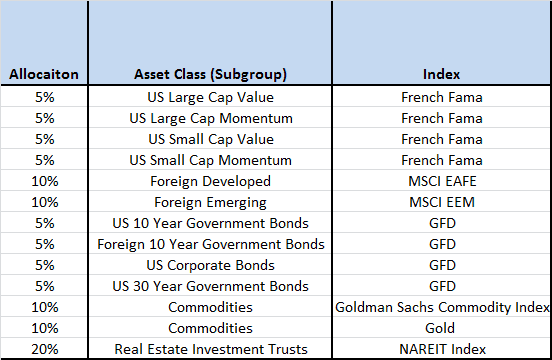Below we have updated our 2006 white paper. While you can download the full 70+ page paper here, I’ve also chopped it up into a series of more digestible posts for the blog.
EXTENSION 3 – WEIGHTING STRATEGIES
No two investors are alike. Some investors value wealth preservation with low volatility above all else, while others can handle a 50% loss in an attempt at generating higher gains.
Below we look at a few different allocations that we will call GTAA Conservative, Moderate, and Aggressive.
GTAA Conservative
This allocation broadly follows the allocation of GTAA Moderate, but with more in bonds (40% vs. 20%). Cash is invested in 10 Year US Government Bonds.
GTAA Moderate
This allocation is the same as mentioned in the prior Extension.
GTAA Aggressive
This portfolio begins with the asset classes listed in the GTAA Moderate allocation. It then selects the top six out of the thirteen assets as ranked by an average of 1, 3, 6, and 12-month total returns (momentum). This method was detailed in our white paper “Relative Strength Strategies for Investing”. The assets are only included if they are above their long-term moving average, otherwise that portion of the portfolio is moved to cash. We also include the effects of only investing in the top three out of thirteen assets.
Another extension we covered is to apply leverage to generate excess returns. An investor would simply invest twice as much in each asset class, and the maximum portfolio exposure would be 200% if all of the asset classes were on buy signals simultaneously.
Note: Implementing the leveraged model at many retail brokerages is not ideal due to prohibitive borrowing costs. Leveraged ETFs likewise are not ideal due to large tracking error relative to the benchmark index. An investor must be careful when pursuing leveraged returns.
Figure 20: Buy & Hold vs. Various GTAA Allocations, 1973-2012




